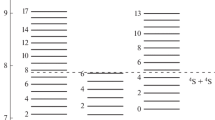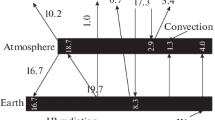Abstract
The processes of excitation and quenching of electronically excited molecular oxygen O2(\({{{\text{A}}}^{3}}\Sigma _{{\text{u}}}^{ + }\)) in the Earth’s atmosphere at nightglow sky heights are considered. The Herzberg I bands in the range of 250–360 nm have a wide spectrum of luminescence in the nightglow of the Earth. The volume intensity profiles of the Herzberg I bands of molecular oxygen in the Earth’s atmosphere are calculated at night using data from a semiempirical model of the temperature response of the middle atmosphere depending on altitude, season, and solar activity at the Earth’s midlatitudes. The calculations of the luminescence intensities of the Herzberg I bands are compared with the experimental data obtained from the Space Shuttle Discovery (STS-53) and from standard SP-48, SP-49, and SP-50 spectrographs from the 1950s–1960s. It is shown that the calculation results are in good agreement with the experimental data obtained from both the space shuttle and ground-based observations.





Similar content being viewed by others
REFERENCES
N. N. Shefov, A. I. Semenov, and V. Yu. Khomich, Radiation of the Upper Atmosphere as an Indicator of its Structure and Dynamics (GEOS, Moscow, 2006) [in Russian].
A. L. Broadfoot and P. J. Bellaire, Jr., “Bridging the gap between ground-based and space-based observations of the night airglow,” J. Geophys. Res. 104 (A8), 17127–17138 (1999).
V. I. Perminov, A. I. Semenov, and N. N. Shefov, “Deactivation of hydroxyl molecule vibrational states by atomic and molecular oxygen in the mesopause region,” Geomagn. Aeron. (Engl. Transl.) 38 (6), 761–764 (1998).
A. I. Semenov and N. N. Shefov, “Variations in the temperature and atomic-oxygen concentration of the mesopause–lower thermosphere region according to variations in solar activity,” Geomagn. Aeron. (Engl. Transl.) 39 (4), 484–487 (1999).
A. I. Semenov and N. N. Shefov, “An empirical model of nocturnal variations in the 557.7-nm emission of atomic oxygen: 1. Intensity,” Geomagn. Aeron. (Engl. Transl.) 37 (2), 215–221 (1997).
N. N. Shefov, A. I. Semenov, and N. N. Pertsev, “Dependencies of the amplitude of the temperature enhancement maximum and atomic oxygen concentration in the mesopause region on seasons and solar activity level,” Phys. Chem. Earth, Part B 25 (5–6), 537–539 (2000).
A. I. Semenov, N. N. Pertsev, N. N. Shefov, V. I. Perminov, and V. V. Bakanas, “Calculation of the vertical profiles of the atmospheric temperature and number density at altitudes of 30–110 km,” Geomagn. Aeron. (Engl. Transl.) 44 (6), 773–778 (2004).
D. R. Bates, “Oxygen band system transition arrays,” Planet. Space Sci. 37 (7), 881–887 (1989).
A. S. Kirillov, “Model of vibrational level populations of Herzberg states of oxygen molecules at heights of the lower thermosphere and mesosphere,” Geomagn. Aeron. (Engl. Transl.) 52 (2), 242–247 (2012).
A. S. Kirillov, “Electronic kinetics of main atmospheric components in high-latitude lower thermosphere and mesosphere,” Ann. Geophys. 28 (1), 181–192 (2010).
A. S. Kirillov, “The calculation of quenching rate coefficients of O2 Herzberg states in collisions with CO2, CO, N2, O2 molecules,” Chem. Phys. Lett. 592, 103–108 (2014).
O. V. Antonenko and A. S. Kirillov, “Modeling the Earth’s nightglow spectrum for systems of bands emitted at spontaneous transitions between different states of electronically excited oxygen molecules,” Bull. Russ. Acad. Sci.: Phys. 85 (3), 219–223 (2021).
V. A. Krasnopolsky, “Excitation of the oxygen nightglow on the terrestrial planets,” Planet. Space Sci. 59 (8), 754–766 (2011).
V. I. Krassovsky, N. N. Shefov, and V. T. Yarin, “Atlas of the airglow spectrum 3000–12400 Å,” Planet. Space Sci. 9 (12), 883–915 (1962).
Author information
Authors and Affiliations
Corresponding author
Ethics declarations
The authors declare that they have no conflicts of interest.
Additional information
Translated by V. Selikhanovich
Rights and permissions
About this article
Cite this article
Antonenko, O.V., Kirillov, A.S. Study of the Earth’s Own Radiation of the Upper Atmosphere (Herzberg I Bands) as a Function of Solar Activity, Atmospheric Temperature, and Seasons of the Year. Izv. Atmos. Ocean. Phys. 58, 578–584 (2022). https://doi.org/10.1134/S0001433822060020
Received:
Revised:
Accepted:
Published:
Issue Date:
DOI: https://doi.org/10.1134/S0001433822060020




